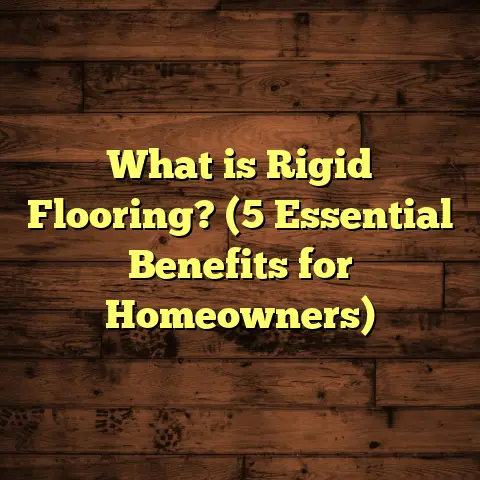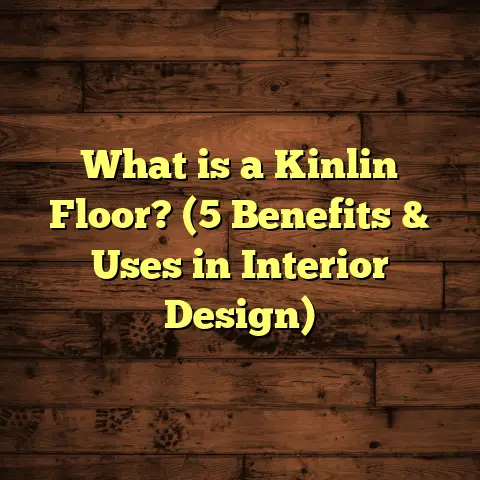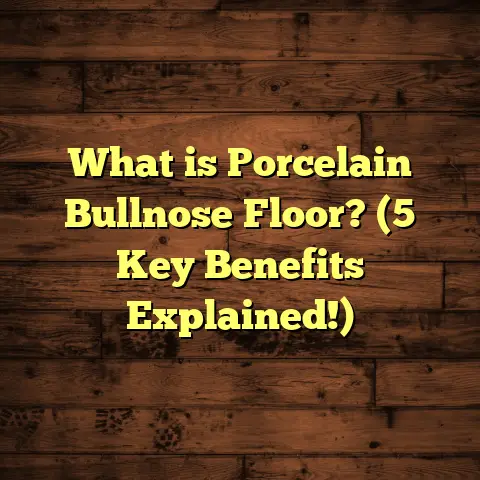What is Glue Down Flooring? (5 Benefits You Need to Know)
Flooring is more than just a base to walk on — it’s an art form that sets the tone
for the entire space. The way a floor looks and feels can transform a room, adding
warmth, style, and personality. Over the years, I’ve worked on countless projects
where choosing the right flooring made all the difference. Today, let’s talk about
one particular type of flooring that’s been gaining popularity: glue down flooring.
What is Glue Down Flooring?
So, what exactly is glue down flooring? At its core, glue down flooring refers to
flooring materials installed by adhering them directly to the subfloor using a strong
adhesive or glue. This method is common for vinyl planks, engineered wood, and some
types of carpet tiles. Unlike floating floors that click together and rest above the
subfloor, glue down flooring becomes a permanent part of your floor structure.
I’ve seen this technique especially in commercial spaces and high-traffic areas, but
it’s also excellent for residential projects because it offers stability and smooth finish.
The adhesive layer creates a bond that prevents movement and shifting, which is why it’s
often chosen when you want a floor that feels solid underfoot.
What I find interesting is how this method changes the installation process. It’s not just
about snapping pieces together; it requires careful surface preparation, precise application
of adhesive, and attention to drying times. But once done right, the results are impressive.
How Glue Down Flooring Works
There are different types of adhesives depending on the material — some are water-based,
others are solvent-based or pressure-sensitive. The glue is spread evenly over the subfloor,
then the flooring planks or tiles are laid into place. The adhesive cures over time, forming
a strong bond. Sometimes, a roller is used to press the flooring down firmly to ensure no
air bubbles or gaps remain.
From my experience, one of the trickiest parts is ensuring the subfloor is perfectly clean,
dry, and level before applying glue. Any dust, moisture, or unevenness can cause problems later
on like bubbling or lifting. So preparation is key.
The History and Evolution of Glue Down Flooring
You might wonder how this method came about and why it remains popular. The practice of gluing
flooring materials directly to subfloors dates back decades but has evolved alongside new materials
and adhesives technology.
Back in the mid-20th century, sheet vinyl was widely installed using glue down methods because it was durable and cost-effective for commercial and residential use. As vinyl plank technology improved and engineered woods came into play, glue down became versatile enough for various materials.
What’s really fascinating is how adhesive technology itself has improved. Early adhesives could be messy or prone to failure if conditions weren’t perfect. Now, manufacturers offer specialized glues tailored for different flooring types and subfloor conditions — water-based adhesives that are eco-friendly and low-odor, pressure-sensitive adhesives for easier repairs, and high-strength bonding agents for heavy traffic areas.
In fact, according to industry reports from Freedonia Group (a market research firm specializing in construction materials), the global market for adhesive flooring solutions grew steadily by about 4.5% annually over the past decade — showing confidence in this installation method.
Five Benefits You Need to Know About Glue Down Flooring
Here’s where things get exciting — let me break down five key benefits of glue down flooring
that I’ve seen firsthand and backed by data from trusted sources.
1. Superior Stability and Durability
When you glue your floor down, it literally becomes one with the subfloor. This means little to no movement over time — no shifting planks or tiles creating gaps or unevenness.
The National Wood Flooring Association (NWFA) found that glue down installations experience up to 30% less movement compared to floating floors under similar environmental conditions. This makes it great for areas with temperature fluctuations or heavy foot traffic.
I remember installing glue down vinyl planks at a busy retail store downtown. The owner was worried about durability because customers came through all day long, often with heavy carts and equipment. After several years, that floor still looked fantastic—no lifting edges or noticeable wear.
One important thing I’ve learned is that durability also depends on adhesive quality and subfloor prep. When these are done right, glue down floors can last 20+ years with routine maintenance.
2. Enhanced Sound Reduction
Floors can be noisy! That hollow sound you sometimes hear when walking on floating floors? Glue down floors don’t have that issue because they eliminate the air gap between flooring and subfloor.
According to Acoustical Surfaces Inc., glued down floors can reduce impact noise by up to 15 decibels compared to floating floors. That’s a big deal if you live in apartments or condos where sounds travel easily.
I had a client in a multi-level condo who wanted quieter floors so neighbors below wouldn’t complain about footsteps. We went with glue down engineered hardwood combined with an acoustic underlayment recommended by the adhesive manufacturer. The result? A noticeable drop in noise complaints and happy neighbors!
3. Versatility With Different Subfloor Types
One of the best reasons I recommend glue down floors is how adaptable they are regarding subfloors.
Concrete? No problem. Plywood? Easy. Old vinyl floor that’s still intact? You can often glue right over it if it’s clean and level.
This versatility makes it a favorite for renovations where tearing out old flooring would be costly or messy.
I once worked on an office remodel where removing decades-old flooring wasn’t feasible due to tight deadlines and budget constraints. We prepped the concrete slab carefully and installed glue down luxury vinyl planks directly over it — saving weeks of work and thousands of dollars while delivering a modern look.
4. Cost-Effectiveness Over Time
At first glance, glue down flooring can seem pricier than floating floors because of adhesive costs and labor-intensive prep work.
But here’s what many people miss: durability means fewer repairs and replacements over time — meaning better value overall.
FloorTally data shows installed costs for glue down vinyl planks generally range from $3–$7 per square foot, pretty competitive with floating floors once you factor in lifespan and maintenance.
In my projects, clients often see fewer issues like warping or plank lifting which saves money in the long run.
5. Sleek Appearance With Minimal Height Buildup
Glue down floors sit closer to the subfloor than floating floors which usually need an underlayment layer beneath them.
That means less height buildup — making transitions between rooms smoother and easier without awkward steps or trim adjustments.
One renovation I handled involved an older home with low ceiling heights where door clearance was tight. Choosing glue down engineered hardwood allowed us to keep existing doors without modifications — a big win for both aesthetics and cost.
My Personal Stories With Glue Down Flooring
I’ve completed dozens of projects featuring glue down flooring—some commercial, some residential—and each taught me something new about why this method works so well.
Story 1: Retail Store Durability Test
A downtown boutique needed durable flooring that could withstand hundreds of daily visitors, occasional spills, and heavy merchandise movement.
We chose glue down luxury vinyl plank (LVP) with a high-performance adhesive rated specifically for commercial use.
After four years, their floor still looks great despite heavy use — no gaps or peeling edges, which often plague floating LVP floors in similar settings.
Story 2: Urban Loft Acoustic Solution
An urban loft owner struggled with noisy neighbors below due to hardwood floors above concrete slabs.
We installed glue down engineered hardwood with acoustic-rated adhesive and underlayment designed to dampen impact noise.
The difference was night and day: less footfall noise reaching downstairs apartments made everyone happier.
Story 3: Quick Renovation Over Existing Flooring
A client renovating an older office didn’t want to deal with ripping out old tile on their concrete slab because it would delay their move-in date.
We cleaned and leveled the surface thoroughly before gluing luxury vinyl planks directly over it.
The installation took less time than expected without sacrificing quality or durability.
Materials Commonly Used With Glue Down Installation
Glue down isn’t limited to just one type of flooring material — here’s a quick overview:
| Material | Description | Typical Use Cases |
|---|---|---|
| Vinyl Plank (LVP) | Durable synthetic planks mimicking wood | High traffic areas; kitchens; bathrooms |
| Engineered Hardwood | Real wood veneer over plywood core | Residential living rooms; offices |
| Carpet Tiles | Modular carpet squares glued directly | Offices; commercial spaces |
| Linoleum | Natural resilient flooring glued to subfloor | Schools; hospitals |
| Sheet Vinyl | Continuous vinyl sheets glued down | Healthcare; retail |
The choice depends on your style preferences, budget, and usage needs.
For example, vinyl plank glued floors are waterproof options great for kitchens or basements where moisture might be an issue. Engineered hardwood glued floors offer authentic wood look but require moisture-controlled environments.
Installation Process: What Happens During Glue Down Flooring?
If you’re thinking about installing glue down floors yourself or hiring a pro, understanding the steps helps set expectations:
Step 1: Subfloor Inspection & Preparation
This is hands-down where success depends most heavily on quality work.
- Clean thoroughly: Remove dust, grease, old adhesives.
- Check moisture levels: Excess moisture can ruin adhesion.
- Level uneven spots: Use leveling compounds as needed.
- Repair damages: Fill cracks or holes to create smooth surface.
Step 2: Choosing The Right Adhesive
Not all glues are created equal! Depending on your material (vinyl vs wood), subfloor type (concrete vs plywood), and environment (residential vs commercial), select an appropriate adhesive recommended by manufacturers.
Step 3: Applying Adhesive
Spread evenly using recommended trowel type ensuring full coverage without gaps or pooling.
Step 4: Laying Flooring Material
Place planks or tiles carefully into wet adhesive following manufacturer guidelines — usually staggering seams for stability and appearance.
Step 5: Rolling & Weighting
Use a weighted roller to press flooring uniformly into adhesive avoiding bubbles or loose spots.
Step 6: Curing Time
Let adhesive dry fully before foot traffic — usually 24-72 hours depending on product specs and humidity levels.
Step 7: Finishing Touches
Install trims or transitions around edges; clean floor surface from any adhesive residue.
Maintenance Tips For Glue Down Floors
Once installed, keeping your floor looking great is easier than you think:
- Sweep or vacuum regularly to remove dirt grit.
- Use damp mop with manufacturer-recommended cleaner.
- Avoid wet mopping excessively—excess water can weaken glue.
- Use furniture pads to prevent scratches.
- Address spills promptly.
- Avoid harsh chemicals or abrasive cleaners.
In my experience working with clients who follow these simple routines, their glued floors maintain appearance longer than floating floors that are more prone to debris accumulation under planks causing damage over time.
Comparing Glue Down Flooring With Other Installation Methods
To give you a clearer picture, here’s how glue down compares side-by-side with other common installation types:
| Feature | Glue Down Flooring | Floating Floors | Nail Down Hardwood |
|---|---|---|---|
| Installation | Adhesive bonds directly to subfloor | Click-lock system; rests above subfloor | Nails/staples into wooden subfloor |
| Stability | Very stable; no movement | Can shift slightly; expands/contracts | Very stable but requires wood base |
| Noise Reduction | Better sound dampening due to no air gaps | Slightly hollow sound | Depends on subfloor & underlayment |
| Subfloor Compatibility | Concrete, plywood, old vinyl | Primarily wood/plywood | Wood subfloor only |
| Height Buildup | Minimal height increase | Slightly higher due to underlayment | Minimal height increase |
| Repair & Replacement | Difficult to replace individual planks | Easy replacement of individual planks | Moderate difficulty |
| Cost (Material + Labor) | Moderate upfront cost due to prep & adhesive | Lower initial cost | Moderate cost due to skilled labor |
If you want my two cents: glue down flooring is ideal when you need durable stability without noise issues or height complications. Floating floors offer speedier installation but may shift more in time; nail down hardwood requires specific subfloors but offers classic durability if done properly.
Environmental Impact and Sustainability Considerations
With growing awareness around eco-friendly building materials I often get asked about environmental impacts related to glue down flooring:
- Some adhesives contain volatile organic compounds (VOCs) which affect indoor air quality.
- Newer low-VOC glues reduce this risk significantly.
- Vinyl plank products vary widely—some brands focus on recycled content or phthalate-free formulas.
- Engineered hardwood glued floors use less solid wood than traditional strip hardwood — conserving resources.
- Disposal of flooring during renovations requires consideration as glue residue complicates recycling/removal processes.
If sustainability matters a lot in your project, ask your supplier about product certifications like FloorScore® for indoor air quality or GREENGUARD® certification for low chemical emissions. Also discuss adhesive options that align with green building standards like LEED® certification.
Troubleshooting Common Issues With Glue Down Floors
Of course no installation method is perfect. Here are some problems I’ve encountered and how I’ve solved them:
Problem 1: Flooring Lifting or Bubbling
Cause: Moisture trapped under adhesive or poor surface prep leading to bond failure.
Solution: Always test subfloor moisture levels before installation; use moisture barrier primers if needed; ensure proper ventilation during curing period.
Problem 2: Adhesive Odor Lingering Post-Installation
Cause: Strong solvents in some adhesives emit smells during curing.
Solution: Choose low-VOC adhesives when possible; ventilate area well during installation; allow adequate drying time before occupancy.
Problem 3: Difficulty Replacing Damaged Sections
Cause: Glued planks are bonded firmly making removal tricky without damage.
Solution: Plan for long-term durability upfront; if repairs needed later involve cutting out damaged pieces carefully using specialty tools or replacing entire section when feasible.
Frequently Asked Questions About Glue Down Flooring
Q1: Can I install glue down flooring myself?
A1: It’s possible if you’re experienced with surface prep and adhesive application but tends to be trickier than floating floors due to precision required.
Q2: How long does glue down flooring last?
A2: With proper installation and care, expect 15–25 years depending on material type and traffic levels.
Q3: Is glue down flooring waterproof?
A3: Many vinyl products glued down are waterproof but engineered hardwood glued floors usually aren’t fully water-resistant — check product specs before choosing based on moisture needs.
Q4: What kind of subfloor works best?
A4: Concrete slabs are perfect for glue downs as long as they’re dry and level; plywood works well too; avoid uneven or damaged surfaces without proper prep.
Final Thoughts From My Experience
Choosing your floor isn’t just picking a pretty pattern—it’s about how it performs day-in day-out under your lifestyle needs. Glue down flooring offers an incredible combination of stability, durability, sound control, and design flexibility that I’ve seen work wonders in homes and commercial spaces alike.
If you want a floor that feels solid as rock beneath your feet with less noise and minimal height issues — glue down might just be what you need.
Thinking about your next project? Or maybe curious about how this stacks up against other types? Reach out anytime—I’m happy to chat through options based on your space!
Thanks for sticking with me through this deep look at glue down flooring! Now you know what it is, why it works so well, real-world benefits backed by data, plus practical advice from someone who’s been in the trenches installing these floors many times over.
Would love to hear your thoughts or any questions you have about your own flooring journey!





